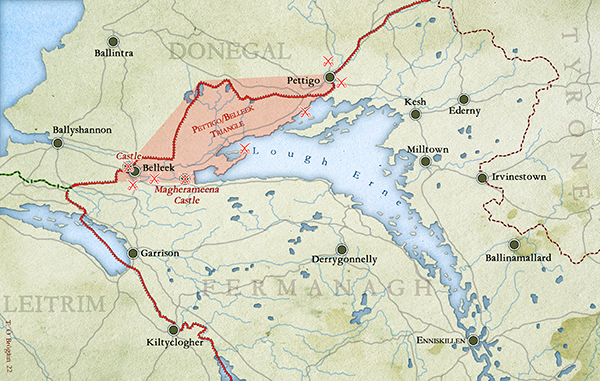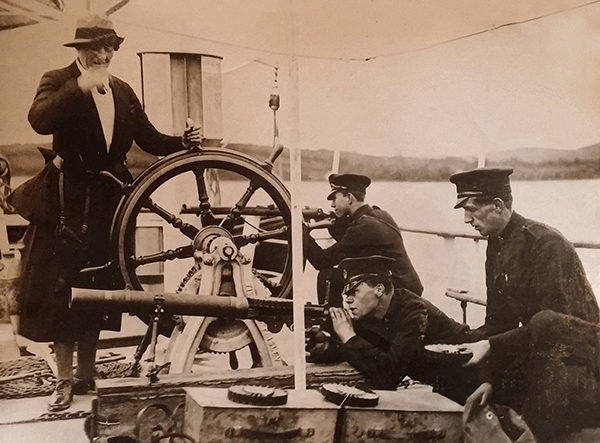THE BATTLE OF THE BELLEEK/PETTIGO TRIANGLE, MAY/JUNE 1922
Published in Features, Issue 3 (May/June 2022), Volume 30By Seán Bernard Newman
BACKGROUND
Until the summer of 1920, Ulster avoided the worst of the revolutionary violence. It was quiet, although far from peaceful, and the conflict in the South seemed a safe distance away across the provincial border. By the end of the revolutionary period, however, Belfast stood out as the bloodiest district on the island.
Serious violence had first flared in June 1920 in the wake of local elections in Derry, when nationalists secured a narrow majority on the borough council. In July 1920 Sir Edward Carson’s annual ‘Twelfth’ speech fired up unionists and called for the re-formation of the Ulster Volunteer Force (UVF) as an auxiliary police force. Five days later (17 July) the IRA killed Col. Gerald Smyth in Cork, which provoked sectarian rioting in his hometown of Banbridge, Co. Down. At the same time unionists violently expelled Catholics and ‘Rotten Prods’ (Protestant trade unionists and socialists) from Belfast’s shipyards, factories and textile mills. A few weeks of uneasy peace ended when the IRA killed District Inspector Oswald Swanzy in Lisburn on 22 August 1920 in retribution for his suspected role in the killing of Thomas MacCurtain (see HI 28.5, Sept./Oct. 2020, pp 40–1). Sectarian violence in the town saw Catholic houses and businesses burnt, and most of the Catholic population fled. In two months sectarian violence shattered Ulster’s relative quiet. At the same time, the UVF re-formed under the direction of future Northern Ireland cabinet secretary Wilfrid Spender. It was transformed into the Ulster Special Constabulary (USC) by November 1920 (see HI 29.2, March/April 2021, pp 34–7).
Sectarian violence spread through Northern Ireland (officially established under the Government of Ireland Act on 3 May 1921) during the next eighteen months. The 11 July 1921 truce ended hostilities in the South but unionists in Northern Ireland worried that peace in the South would allow the IRA to direct their attention exclusively against the North. By February 1922 Michael Collins was seeking to paper over the cracks between the pro- and anti-Treaty IRA by doing just as unionists had feared: he established the ‘Army of the North’—made up of both pro- and anti-Treaty IRA—and prepared a ‘joint IRA offensive’ against Northern Ireland that came to a head at Belleek–Pettigo in June.
VIOLENCE ON THE BORDER
Twelve IRA prisoners embarked on an unsuccessful escape from Derry Gaol on 2 December 1921, killing an RIC constable and a USC special constable with a chloroform overdose in the process. On 14 January 1922 the USC detained ten armed men, ‘the Monaghan footballers’—apparently on their way to a GAA game or, according to the USC, attempting to break the ‘Derry prisoners’ out of gaol—at Dromore, Co. Tyrone. By January 1922 the joint IRA offensive looked not only to unite pro- and anti-Treatyites but also to pressure Northern Ireland’s prime minister, Sir James Craig, into releasing the men in Derry Gaol. Clady, Co. Tyrone, on the border became a flashpoint when on 19 January 1922 the IRA and ‘A’ Specials engaged in a shoot-out after a unionist-owned bakery van crossed the border, breaking the Belfast Boycott. Things heated up further in February when the IRA kidnapped two local unionists, and boiled over on 7/8 February when they launched an extensive and coordinated operation against the border in counties Armagh, Fermanagh and Tyrone.
Highlighting the inadequacy of the USC, the IRA kidnapped around 30 unionists, including 28 ‘B’ Specials, a deputy lieutenant and other prominent men. Home Affairs minister Richard Dawson Bates telegrammed Craig to tell him of the ‘invasion’. In a further demonstration of the force’s ineffectiveness, the next night—9/10 February—‘A’ and ‘B’ Specials escorted an army ambulance through Free State territory to tend to the wounded. Predictably, the IRA detained the USC men and let the ambulance drivers go. Despite sky-high tensions on the border, armed ‘A’ Specials—sent from Newtownards to reinforce the border—took a train through County Monaghan, intending to change at Clones station on the Free State side. A gunfight (including the IRA’s use of Thompson submachine-guns) ensued: four ‘A’ Specials were killed, seven were wounded and five were captured (see HI 12.3, Autumn 2004, pp 33–7). By the end of the week, 42 unionists sat in Monaghan court-house, detained by the IRA. The joint IRA offensive failed to prevent the Irish Civil War but it succeeded in releasing the ‘Derry prisoners’ and the ‘Monaghan footballers’. On the morning of 20 February 1922, Lord Lieutenant FitzAlan—much to Craig’s chagrin—ordered their release and, in turn, the 42 unionists were released. The atmosphere on the border, however, remained febrile. A battered and bruised USC stepped up their patrols, while the IRA grew in numbers on the Free State side.
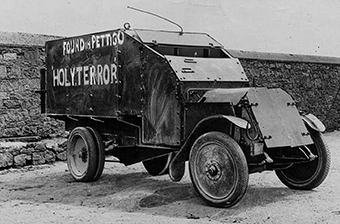
Above: ‘Found in Pettigo’ – USC ‘A’ Specials attempted to hold the road out of the ‘triangle’ to Northern Ireland (which ran through the Free State) with an attack on 28 May 1922 led by this Lancia armoured car, which was captured by the IRA; it was later recaptured by British forces.
THE BATTLE
The killing of Unionist MP William Twaddell in Belfast on 22 May 1922 led to a security crackdown against the IRA and nationalists in Northern Ireland. Many of the former fled to the safety of the Free State. By the end of the month, northern IRA men joined with their southern comrades and waited just across the County Fermanagh border in the small town of Pettigo, Co. Donegal. Reports in the unionist press of thousands of ‘IRA troops’ massed on the border were far-fetched, but ‘A’ Specials nevertheless responded with a build-up of their own. Heavy skirmishing took place on 22–27 May 1922 before the IRA crossed the border 3km to the south-west into the Belleek–Pettigo ‘triangle’.
Cut off from the rest of Northern Ireland by Lower Lough Erne to the south and east and by Free State territory to the north and west, the only access to the ‘triangle’ was by boat across the lough or along roads running through County Donegal. It presented an easy target for the IRA, who quickly occupied the area on 27 May, with only a small force of ‘A’ Specials—who had pre-emptively crossed Lough Erne the same day—holding Magherameena Castle. ‘A’ Specials attempted to hold the road out of the ‘triangle’ to Northern Ireland—which ran through the Free State—with an attack on 28 May led by an armoured Lancia followed by Crossley tenders. IRA gunfire killed the driver of the Lancia, which crashed into the ditch, followed by the tenders. The ‘A’ Specials withdrew to the castle. Under attack from the IRA, the ‘A’ Specials abandoned the castle and fell back to the shore, to be rescued unexpectedly by the proprietor of the local pleasure steamer company.
THE ‘ADMIRAL’
Hazel Laverton cuts a striking figure in the events of May/June 1922—and in the silent newsreel of the time. We find Mrs Laverton in newspaper reports from the year before. Her husband—a retired senior army officer—abandoned her in Fermanagh and, in an era when many women simply put up with the slight and hardship of estrangement, Mrs Laverton sued him for ‘restitution of her conjugal rights’. Neither did she retire heartbroken: she ran a pleasure steamer company on Lough Erne. Just as she confronted her husband in 1921, she confronted the IRA in 1922. Seeing the plight of the ‘A’ Specials, she sailed the SS Pandora, already carrying another party of ‘A’ Specials, towards the shoreline to rescue them. She noticed a group of IRA Volunteers flanking the stranded men on the shore and pulled her boat about, positioning it so that the Specials on board could direct their fire on the IRA party, who promptly retreated. During this incident, she put her telescope on a tripod to fool the attackers into thinking that she had a machine-gun, and then rowed out in a small boat to fix the steamer’s anchor while coming under IRA fire; armed with a rifle, she fired back. As the evacuation of the ‘A’ Specials began, the IRA opened the sluice-gates of the lake to drop the water level and ground the steamer. Undeterred by IRA fire, Mrs Laverton again got into the rowing-boat and released the anchor to sail into deeper water.
After this successful evacuation, the Royal Navy adopted the SS Pandora and designated it a flagship with the new name of HMS Pandora. Mrs Laverton retained command of her pleasure steamer and became the first woman to command a Royal Navy vessel, earning her the nickname ‘Admiral Mrs Laverton’. Interviewed a few days later—with a miniature pistol in her belt— Hazel Laverton dismissed all the fuss, while newsreel shows her in full command of ‘Ulster’s little navy’, ordering ‘A’ Specials with rifles and a Lewis gun to positions on her deck.
THE ARTILLERY
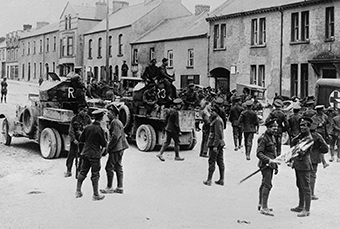
Above: British troops reoccupying Belleek, Co. Fermanagh, after 8 June 1922, following its temporary ‘liberation’ by the IRA.
Craig’s USC had assumed the role of frontier troops but had consistently failed when confronted with organised attacks. The failures of 1922 saw the regular British army restored to border duties. Collins assured Winston Churchill, the colonial secretary, that the IRA occupiers had nothing to do with the Free State. On 4 June 1922, Crown forces moved against them. Pettigo fell first with little resistance; the army outflanked the village and occupied ground a mile into Free State territory. A furious Collins accused the London government of using Specials and Black and Tans during the operation.
Three days later, Crown forces launched an amphibious operation across Lough Erne and quickly occupied most of the ‘triangle’, rasing Magherameena Castle in the process. The amphibious force waited just outside Belleek, which remained occupied by the IRA. The next morning another British army column advanced from Pettigo and formed the second arm in a pincer movement to recapture Belleek. At 10am on 8 June 1922 Crown forces began an artillery barrage targeted mostly at Belleek Fort, which sat above the town just inside Free State territory, in County Donegal. After a few hours of machine-gun exchanges, IRA forces withdrew by 1pm, leaving the British army to march into the abandoned town and restore the territorial integrity of Northern Ireland. They remained in occupation of Belleek Fort until 1924.
REORGANISING THE SPECIALS
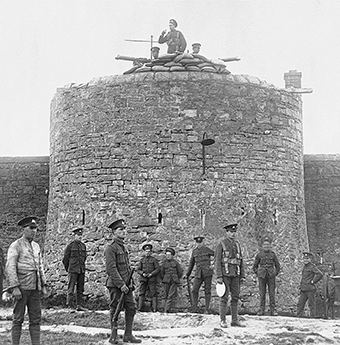
Above: British soldiers of the Lincolnshire Regiment occupy Belleek Fort (a.k.a. the Battery) on the County Donegal side of the border, 25 August 1922. British forces remained there until 1924.
The first six months of 1922 exposed the USC as ineffective against organised and coordinated attack. Despite formal disbandment after the July 1921 Truce, it had remained intact until officially re-established by Craig in February 1922. Many of the Specials performed bravely in the face of personal danger, but as a force the USC better fitted the role of sectarian policing—and, in the case of the ‘B’ class, communal repression. In April 1922 Craig appointed General Arthur Solly-Flood as military adviser to Northern Ireland. Solly-Flood quickly went about reorganising the USC and introduced the ‘C1’ Special class, which he planned to use not only to protect the border but also to invade and occupy parts of counties Monaghan and Donegal.
Despite the enthusiasm of the Northern Irish government for ‘Ulster’s Army’, the War Office in London refused Solly-Flood’s demands for bombers and tanks. It became clear that the ‘A’ and ‘B’ Specials must give up their pretensions of being a frontier fighting force. Both Northern Ireland and the Free State accepted British proposals to keep the peace through ‘neutral zones’ at flashpoints on the border. Solly-Flood pushed for Crown forces to control the entire border, supported by unarmed Specials—the ‘zone police’—in Northern Irish townlands. The refusal of the ‘B’ Specials to hand over their weapons meant, however, that the neutral zone plan collapsed and tensions remained on the border, even if they did not boil over as they had in 1922. For the time being—until Craig and W.T. Cosgrave agreed a permanent border settlement in 1927—the regular British army took on border duties alongside ‘B’ Specials.
Seán Bernard Newman holds a Ph.D from Birkbeck, University of London.
Further reading
M. Lewis, Frank Aiken’s war: the Irish revolution, 1916–23 (Dublin, 2014).
R. Lynch, The Northern IRA and the early years of partition 1920–1922 (Dublin, 2006).
O. Ozseker, Forging the border: Donegal and Derry in times of revolution, 1911–1925 (Newbridge, 2019).
A.F. Parkinson, Belfast’s unholy war: the Troubles of the 1920s (Dublin, 2004).










